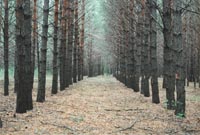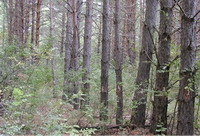|
|
УДК 630.561.21:
634.164.4:630.174.754
Influence of Environmental Factors on Growth of
the
Archangel Fir Trunk in the Forest-Steppe Prebaikalia Download PDF (96
KB)
V.F. Zabuga,
G.A. Zabuga
Angarsk State
Technical Academy MD of Russian
Federation
Angarsk, Russia
Volume
XXIV,
Number 1, 2006
Abstract
During almost
30-years supervision investigated dependence of growth in height and on
radius
of a trunk of a pine ordinary from
original climatic conditions of forest-steppe zone Predbaical. It is
established, that duration of the period of linear growth of a trunk
averaged
55, and radial - about 80 days. Annual changes of a gain of axial
runaway and a
trunk on radius changed synchronously to what the factor of pair
correlation -
0.68 testified. Variability of a linear gain in height was appreciably
defined
by conditions влагообеспеченности environments -
humidity of air and the sums of deposits for its period of growth
without and
in view of September of the previous year. Variability of a gain of a
trunk on
radius depends basically on variability of average for the period of
its growth
of temperature and humidity of air. Dependence between a gain of a
trunk in
height and on radius and factors of an environment has expressed
rectilinear
function. However the degree of approximation of dependences linear
function
was less, than polynomial. Plural correlation connection testified to
significant influence on growth of axial runaway of a pine of quantity
of
deposits in September of the previous year. Without taking into account
the
last influence of average for the period of growth of temperature and
humidity
of air, the sum of deposits was approximately identical as for верхушечного, and radial
growth of a trunk of a pine
ordinary. It is established, for radial growth a combination of the big
amplitude of annual fluctuations of width of year rings (116 %) and a
low share
of influence on it of researched factors of an environment (r2=19-24
%). For верхушечного growth the
combination of small amplitude of annual fluctuations of length of
axial runaway
(72 %) to a high share of influence on it of external conditions (r2=28-44
%), on the contrary, was typical.
References
- 1.
Feliksik E.,
Wilczynski S. The influence of thermal
and pluvial conditions on the radial increment of the Scots pine (Pinus
sylvestris Ll) from the area of Donly Ślarsk // Folia forest. pol. A.-
2000.-№
42, P.55-
- 2.
Gavrikov V.L.,
Secretenko O.P. Shoot-based
three-dimensional model of young Scots pine growth// Ecological
Modelling.-
1996.-V.88.-№1-3.-P.183-193.
- 3.
Oberhuber W.,
Kofler W. Topographic influences on
radial growth of Scots pine (Pinus sylvestris L.) at small
spatial scales
// Plant Ecol.- 2000.-V.146.-№ 2.-P.231-240.
- 4.
Pasanen K.
Integrating variation in tree growth into forest planning //Silva.
fenn.-1998.-V.32.-№ 1.-P.11-25.
- 5.
Wilczyński S,
Skrzyszewski J. The climatic in
tree-rings of Scots pine (P.sylvestris L.) from foot-hills of the
Sudetic
Mountains (southern Poland) // Forstwiss. Cbl.- 2002.- V.121.-№
1.-P.15-24.
- 6.
Влияние условий произрастания на
структуру годичного
слоя древесины и продуктивность сосны обыкновенной /
Г.Ф. Антонова [и др.] // Лесоведение.-1999.- №
6.- С.
45-53.
- 7.
динамика камбиальной активности и
дифференциации
трахеид в стволе сосны обыкновенной / Г.Ф.Антонова [и др.] // Химия
древесины.-1983.-№ 1.- С.16-22.
- 8.
Атлас Иркутской области.- М.
– Иркутск, 1963.-182 с.
- 9.
Бояркин, В.М. География Иркутской
области. Очерки по
физической географии Иркутской области.- М.: Изд-во МВ и ССО
РСФСР-ИГУ им.
А.А.Жданова, 1972.-294 с.
- 10.
Ваганов, Е.А., Шашкин, А.В. Рост и
структура годичных
колец хвойных.- Новосибирск: Наука, 2000.-233 с.
- 11.
Вербила, В.В., Шлейнис, Р.И.
Сезонный рост сосны и его
изменения под влиянием минеральных удобрений// Лесоведение.-1981.- №
2.-
С.12-18.
- 7.
Елагин, И.Н. Сезонное
развитие
сосновых лесов.- Новосибирск: Наука, 1976.- 232 с.
- 8.
Забуга, В.Ф., Забуга,
Г.А. Взаимосвязь ростовой активности кроны с радиальным приростом ствола сосны обыкновенной//
Лесоведение.- 1990.- № 4.- С.19-24.
- 9.
Забуга, В.Ф., Забуга, Г.А. Сезонный
рост сосны
обыкновенной в лесостепи Предбайкалья // Экология.- 1992.- № 2.- С.11-18.
- 10.
Забуга, В.Ф., Забуга, Г.А.
Зависимость радиального
прироста сосны обыкновенной от факторов внешней среды в лесостепи
Предбайкалья//Лесоведение.-2003.- № 5.- с.30-37.
- 11.
Захаров В.К. Лесная таксация.- М.: Высшая школа, 1961.- 360 с.
- 12.
Кищенко, И.Т. Сезонный
рост побегов и хвои сосны в разных частях кроны // Лесоведение.-1983.-
№ 3.-С.
27-32.
- 13.
Лебеденко, Л.А.
Деятельность камбия лиственницы в связи с фенотипом // Лесная генетика,
селекция
и семеноводство.- Петрозаводск: Изд-во Карелия, 1970.-
С.47-55.
- 14.
Лобжанидзе, Э.Д. Камбий и
формирование годичных колец
древесины.- Тбилиси: Изд-во АН ГССР, 1961.-159 с.
- 15.
Макаревский М.Ф. Закономерности
роста растений // Физиолого-биохимические
основы роста и адаптации сосны на Севере.- Л., 1985.-С.12-29.
- 16.
Меняйло, Л.Н. Гормональная регуляция ксилогенеза хвойных.-
Новосибирск: Наука,
1987.-184 с.
- 17.
Прокушкин, С.Г. Минеральное питание
сосны.-
Новосибирск: Наука,1982.- 190 с.
______________________________
|
|
|





